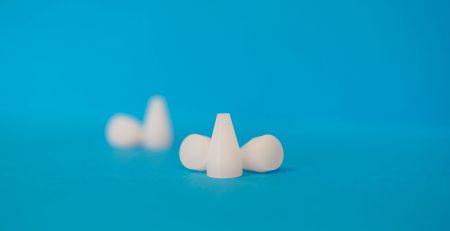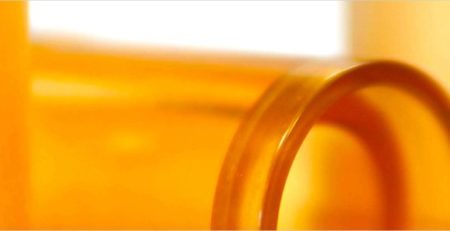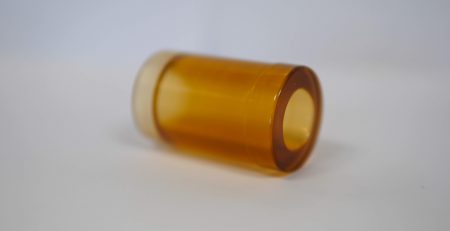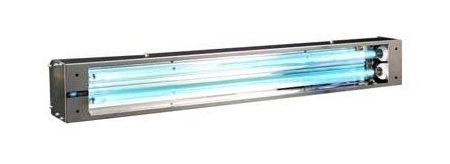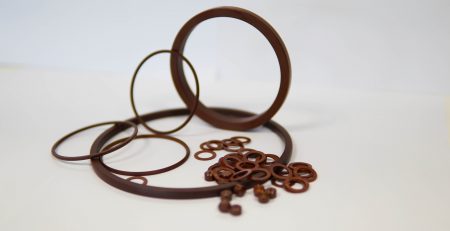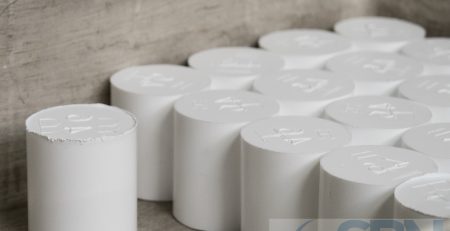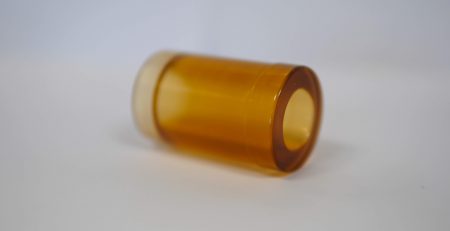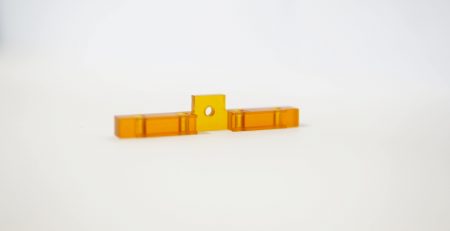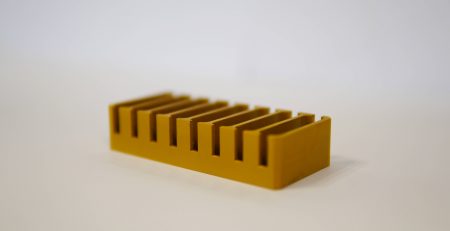PCTFE Chemical compatibility
PCTFE Chemical compatibility
PCTFE is a homopolymer of chlorotrifluoroethylene (CTFE) marketed as Kel-F, Voltalef or Aclar. It differs from PTFE by the addition of a chlorine atom to its chemical structure, which gives it a relatively low melting point compared to other fluoropolymers. This plastic is particularly popular for its physical and mechanical properties combined with its resistance to heat, cryogenic temperatures and electrical properties. Its chemical stability is also one of the most appreciated characteristics of PCTFE, providing good gas and moisture impermeability.
PCTFE is a high-performance material that is highly resistant to oxidation. Since it contains no hydrogen atoms, this plastic has a high chemical resistance to certain chemical components and oxidizing agents. In particular, it has excellent (Class A) to good (Class B) compatibility with certain acetates, alcohols, sulphates and acids. However, it is not recommended to expose it to ethers and halocarbons which cause its deterioration.
PCTFE is a crystalline polymer with excellent tensile and creep strength. It is stiffer and stronger than PTFE and has good flammability resistance and is frequently used in the industrial and aerospace sectors. At SPN, you have access to various PCTFE semi-finished products in bar, plate or tube form. Thanks to its impermeability, this material can also be used in the manufacture of gaskets and other machined parts.
The table below summarizes the chemical compatibility of PCTFE according to ISO 11114-2:2013(F): “Gas cylinders – Compatibility of cylinder and valve materials with gas contents”:
| N° ONU | Nom | PCTFE | Commentaire |
| 98 (2035) | TRIFLUORO-1,1,1 ETHANE | Acceptable Swelling | |
| 39 (1030) | DIFLUORO-1,1-ETHANE | Acceptable Swelling | |
| 40 (1959) | DIFLUORO-1,1-ETHYLENE | Acceptable Swelling | |
| 97 (3082) | TRICHLORO-2 TRIFLUORO-1,2,2 ÉTHANE | Acceptable Swelling | |
| 36 (1958) | DICHLORO-1,2 TÉTRAFLUORO-1,1,2,2 ÉTHANE | Acceptable Swelling | |
| 38 (2517) | DIFLUORO(1,1)-1- CHLOROÉTHANE | Acceptable Swelling | |
| 24 (1021) | CHLORO-1 TÉTRAFLUORO-1,2,2,2 ÉTHANE | Acceptable | |
| 113 (3161) | DIFLUORO(1,2)-1- CHLOROÉTHANE | Acceptable | |
| 25 (1983) | CHLORO-1 TRIFLUORO- 2,2,2 ÉTHANE | Acceptable Swelling | |
| 117 (2044 | 2,2-DIMETHYLPROPANE | Acceptable | |
| 1 (1001) | ACÉTYLÈNE | Acceptable | Certains matériaux ne sont pas compatibles en raison du solvant utilisé |
| 105 (1002) | AIR | Acceptable Inflammable | À haute pression, risque de réaction violente due à l’oxygène. |
| 2 (1005) | AMMONIAC | Acceptable | |
| 3 (1006) | ARGON | Acceptable | |
| 4 (2188) | ARSINE | Acceptable | |
| 5 (1741) | TRICHLORURE DE BORE | Acceptable | |
| 6 (1008) | TRIFLUORURE DE BORE | Acceptable | |
| 9 (2419) | BROMOTRIFLUOROETHY- LÈNE | Acceptable Swelling | |
| 8 (1009) | BROMOTRIFLUOROME- THANE | Acceptable Swelling | |
| 10 (1010) | BUTADIENES | Acceptable | |
| 12 (1011) | BUTANE | Acceptable | |
| 13 (1012) | BUTYLENE | Acceptable | |
| 16 (1013) | DIOXYDE DE CARBONE | Acceptable | |
| 17 (1016) | MONOXYDE DE CARBONE | Acceptable | |
| 109 (2417) | FLUORURE DE CARBONYLE | Acceptable | |
| 19 (2204) | SULFURE DE CARBONYLE | Acceptable | |
| 20 (1017) | CHLORE | Acceptable | Avertissement: il existe un risque de réactions violentes |
| 110 (1589) | CHLORURE DE CYANOGÈNE | Acceptable | |
| 111 (2548) | PENTAFLUORURE DE CHLORE | Acceptable | |
| 112 (1749) | TRIFLUORURE DE CHLORE | Acceptable | |
| 7 (1974) | BROMOCHLORODI- FLUOROMÉTHANE | Acceptable Swelling | |
| 21 (1018) | CHLORODIFLUOROMÉ- THANE | Acceptable Swelling | |
| 23 (1020) | CHLOROPENTAFLUOROÉ- THANE | Acceptable Swelling | |
| 27 (1022) | CHLOROTRIFLUOROMÉ- THANE | Acceptable Swelling | |
| 37 (1026) | CYANOGÈNE | Acceptable | |
| 28 (1027) | CYCLOPROPANE | Acceptable | |
| 29 (1957) | DEUTÉRIUM | Acceptable | |
| 32 (1911) | DIBORANE | Acceptable | |
| 30 (1941) | DIBROMODIFLUOROMÉ- THANE | Acceptable Swelling | |
| 31 (N° ONU non assigné) | DIBROMOTÉTRA- FLUOROÉTHANE | Acceptable Swelling | |
| 33 (1028) | DICHLORODIFLUOROMÉ- THANE | Acceptable Swelling | |
| 34 (1029) | DICHLOROFLUOROMÉ- THANE | Acceptable Swelling | |
| 35 (2189) | DICHLOROSILANE | Acceptable | |
| 41 (1032) | DIMÉTHYLAMINE | Acceptable | |
| 42 (1033) | ÉTHER DIMÉTHYLIQUE | Acceptable | |
| 118 (3161) | DIMÉTHYLSILANE | Acceptable | |
| 76 (1067) | TÉTROXYDE DE DIAZOTE (DIOXYDE D’AZOTE) 3) | Acceptable | Avertissement: il existe un risque de réactions violentes. |
| 43 (3161) | DISILANE | Acceptable | |
| 44 (1035) | ÉTHANE | Acceptable | |
| 46 (1037) | CHLORURE D’ÉTHYLE | Acceptable Swelling | |
| 50 (2453) | FLUORURE D’ÉTHYLE | Acceptable Swelling | |
| 121 (1039) | MÉTHOXYÉTHANE | Acceptable | |
| 120 (2452) | ÉTHYLACÉTYLÈNE | Acceptable | |
| 45 (1036) | ÉTHYLAMINE | Acceptable | |
| 47 (1962) | ÉTHYLÈNE | Acceptable | |
| 48 (1040) | OXYDE D’ÉTHYLÈNE | Acceptable | |
| 53 (2192) | GERMANE | Acceptable | |
| 54 (1046) | HÉLIUM | Acceptable | |
| 122 (3296) | HEPTAFLUOROPROPANE | Acceptable | |
| 123 (2420) | HEXAFLUOROACÉTONE | Acceptable | |
| 56 (1858) | HEXAFLUOROPROPY- LÈNE | Acceptable Swelling | |
| 57 (1049) | HYDROGÈNE | Acceptable | |
| 58 (1048) | BROMURE D’HYDROGÈNE | Acceptable | |
| 59 (1050) | CHLORURE D’HYDROGÈNE | Acceptable | |
| 60 (1051) | CYANURE D’HYDROGÈNE | Acceptable | |
| 61 (1052) | FLUORURE D’HYDROGÈNE | Acceptable | |
| 62 (2197) | IODURE D’HYDROGÈNE | Acceptable | |
| 124 (2202) | SÉLÉNURE D’HYDROGÈNE | Acceptable | |
| 63 (1053) | SULFURE D’HYDROGÈNE | Acceptable | |
| 64 (1969) | ISOBUTANE | Acceptable | |
| 65 (1055) | ISOBUTYLÈNE | Acceptable | |
| 66 (1056) | KRYPTON | Acceptable | |
| 67 (1971) | MÉTHANE | Acceptable | |
| 69 (1062) | BROMURE DE MÉTHYLE | Acceptable | |
| 51 (2454) | FLUORURE DE MÉTHYLE | Acceptable Swelling | |
| 70 (1064) | MERCAPTAN DE MÉTHYLE | Acceptable | |
| 126 (2455) | NITRITE DE MÉTHYLE | Acceptable | |
| 68 (3161) | MÉTHYLACÉTYLÈNE | Acceptable | |
| 72 (1061) | MÉTHYLAMINE | Acceptable | |
| 22 (1063) | CHLORURE DE MÉTHYLE | Acceptable | |
| 125 (2534) | MÉTHYLCHLOROSILANE | Acceptable | |
| 71 (3161) | MÉTHYLSILANE | Acceptable | |
| 73 (1065) | NÉON | Acceptable | |
| 75 (1066) | AZOTE | Acceptable | |
| 78 (2451) | TRIFLUORURE D’AZOTE | Acceptable | Avertissement: Il existe un risque de réactions violentes |
| 119 (2421) | TRIOXYDE D’AZOTE | Acceptable | Avertissement: Il existe un risque de réactions violentes |
| 77 (1070) | HÉMIOXYDE D’AZOTE | Acceptable | Avertissement: Il existe un risque de réactions violentes |
| 81 (2424) | OCTAFLUORO PROPANE | Acceptable Swelling | |
| 79 (2422) | OCTAFLUOROBUTÈNE-2 | Acceptable Swelling | |
| 80 (1976) | OCTAFLUORO- CYCLOBUTANE | Acceptable Swelling | |
| 82 (1072) | OXYGÈNE | Oxygen compatibility BAM (gas). | Avertissement: Il existe un risque de réactions violentes |
| 127 (3220) | PENTAFLUOROÉTHANE | Acceptable | |
| 128 (3083) | FLUORURE DE PERCHLORYLE | Acceptable | |
| 129 (3154) | PERFLUORO (ÉTHYL VINYL ÉTHER) | Acceptable | |
| 130 (3153) | PERFLUORO (MÉTHYL VINYL ÉTHER) | Acceptable | |
| 83 (1076) | PHOSGÈNE | Acceptable | |
| 84 (2199) | PHOSPHINE | Acceptable | |
| 131 (2198) | PENTAFLUORURE DE PHOSPHORE | Acceptable | |
| 86 (2200) | PROPADIENE | Acceptable | |
| 85 (1978) | PROPANE | Acceptable | |
| 87 (1077) | PROPYLENE | Acceptable | |
| 88 (1280) | OXYDE DE PROPYLENE | Acceptable | |
| 132 (2194) | HEXAFLUORURE DE SÉLÉNIUM | Acceptable | |
| 89 (2203) | SILANE | Acceptable | |
| 90 (1818) | TETRACHLORURE DE SILICIUM | Acceptable | |
| 91 (1859) | TETRAFLUORURE DE SILICIUM | Acceptable | |
| 106 (2676 | STIBINE | Acceptable | |
| 133 (2191) | FLUORURE DE SULFURYLE | Acceptable | |
| 92 (1079) | DIOXYDE DE SOUFRE | Acceptable | |
| 93 (1080) | HEXAFLUORURE DE SOUFRE | Acceptable | |
| 94 (2418) | TETRAFLUORURE DE SOUFRE | Acceptable | |
| 134 (2195) | HEXAFLUORURE DE TELLURE | Acceptable | |
| 95 (1081) | TETRAFLUOROETHYLENE | Acceptable | |
| 96 (1295) | TRICHLOROSILANE | Acceptable | |
| 100 (2196) | HEXAFLUORURE DE TUNGSTÈNE | Acceptable | |
| 101 (1085 | BROMUREDEVINYLE | Acceptable Swelling | |
| 102 (1086 | CHLORUREDEVINYLE | Acceptable Swelling | |
| 103 (1860 | FLUORUREDEVINYLE | Acceptable Swelling | |
| 135 (1087 | VINYLEMETHYLEETHER | Acceptable | |
| 104 (2036 | XENON | Acceptable |



